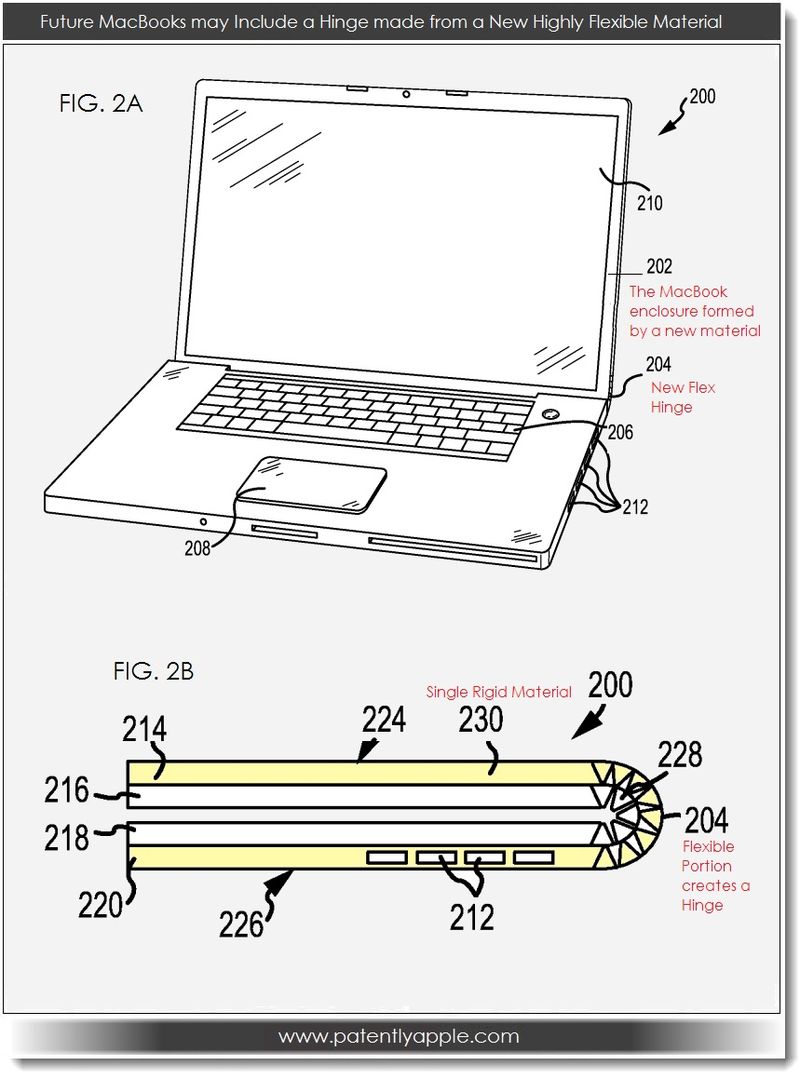Apple has invented a method for flexing rigid material potentially eliminating the need for hinge mechanisms on the MacBook and other products.
In a recently published patent entitled, "INTERLOCKING FLEXIBLE SEGMENTS FORMED FROM A RIGID MATERIAL", Apple notes that many electronic devices, peripheral components or devices (such as speakers, headphones, keyboards, etc.) may include housings or enclosures made of a relatively rigid material, such as plastic or metal. These types of enclosures are typically at least somewhat rigid in order to provide protection for internal components housed within the enclosures. However, due to the rigidity of the material, in order for these type of enclosures or housings to bend or flex, a separate element, such as a hinge, may need to be connected to the rigid material. These additional components may increase the size of the enclosures and thus the size of the electronic devices or peripheral devices, as well as increase manufacturing costs as additional components may need to be assembled together.
Apple details a method for creating an enclosure from a rigid material and removing sections of the rigid material to create a geometric pattern of interlocking features. This pattern determines the flex of the rigid material.
Embodiments may take the form of an enclosure formed of a substantially rigid material. The enclosure may include a first plurality of flex apertures defined within the rigid material along a first row and a second plurality of flex apertures defined within the rigid material along a second row. The second row is positioned below the second row and the first plurality of flex apertures are misaligned with the second plurality of flex apertures such that a first end of each of the first plurality of flex apertures is in a different vertical plane from a first end of each of the second plurality of flex apertures. When a bending force is applied to one of the first row or the second row, the first plurality of flex apertures and the second plurality of flex apertures vary in shape or dimension, allowing the rigid material to bend.
More details at the link below...
Read More [via PatentlyApple]


In a recently published patent entitled, "INTERLOCKING FLEXIBLE SEGMENTS FORMED FROM A RIGID MATERIAL", Apple notes that many electronic devices, peripheral components or devices (such as speakers, headphones, keyboards, etc.) may include housings or enclosures made of a relatively rigid material, such as plastic or metal. These types of enclosures are typically at least somewhat rigid in order to provide protection for internal components housed within the enclosures. However, due to the rigidity of the material, in order for these type of enclosures or housings to bend or flex, a separate element, such as a hinge, may need to be connected to the rigid material. These additional components may increase the size of the enclosures and thus the size of the electronic devices or peripheral devices, as well as increase manufacturing costs as additional components may need to be assembled together.
Apple details a method for creating an enclosure from a rigid material and removing sections of the rigid material to create a geometric pattern of interlocking features. This pattern determines the flex of the rigid material.
Embodiments may take the form of an enclosure formed of a substantially rigid material. The enclosure may include a first plurality of flex apertures defined within the rigid material along a first row and a second plurality of flex apertures defined within the rigid material along a second row. The second row is positioned below the second row and the first plurality of flex apertures are misaligned with the second plurality of flex apertures such that a first end of each of the first plurality of flex apertures is in a different vertical plane from a first end of each of the second plurality of flex apertures. When a bending force is applied to one of the first row or the second row, the first plurality of flex apertures and the second plurality of flex apertures vary in shape or dimension, allowing the rigid material to bend.
More details at the link below...
Read More [via PatentlyApple]



